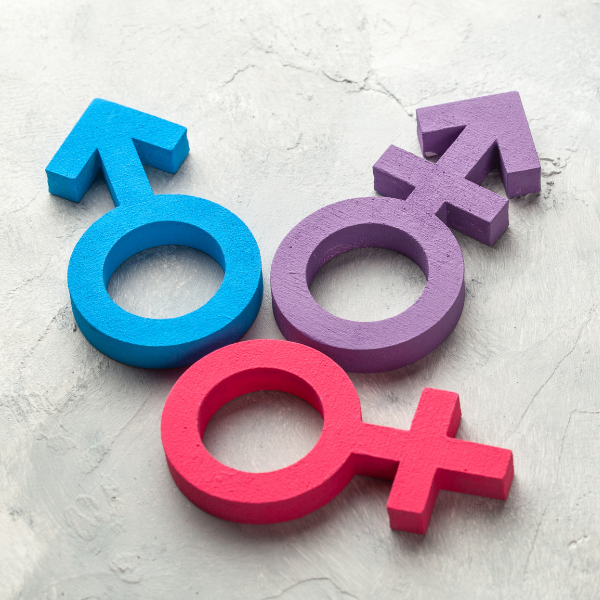Article written in collaboration with Susanna Cordone, Professor of General Psychology at UniCamillus
News headlines about bullying and discrimination against people who want to live their sexuality freely are commonplace. In 2024, society still does not seem to be inclusive of those who do not fit into the statistical majority, making it even more difficult for people with different sexual choices, whether they be related to gender or orientation. Sex remains a taboo subject, despite the hypersexualisation of values. Our so-called freedom is only accepted if it conforms to predetermined norms.
Life is not easy for those who choose not to conform to these predetermined norms, including transgender people, who experience an incongruity between their biological sex assigned at birth and their psychological identity. They may live in a woman’s body but identify as a man, or vice versa.
“It is important to distinguish incongruity from gender dysphoria“, stresses Susanna Cordone, Professor of General Psychology at UniCamillus. “Incongruity can be defined as a condition in which a person’s gender identity does not correspond to the sex assigned at birth, while dysphoria refers to the suffering and discomfort caused by this misalignment”. A crucial criterion for the diagnosis of gender dysphoria in both adults and children, according to the DSM-V-TR® (Diagnostic and Statistical Manual of Mental Disorders, Fifth Edition, Text Revision), is a strong sense of distress and suffering that accompanies the discrepancy between physical reality and self-perception.
This necessary distinction is crucial to understanding that not all transgender people experience gender dysphoria.
Gender dysphoria can begin in childhood
Gender dysphoria can begin in childhood, as the DSM-V-TR® distinguishes diagnostic criteria for adolescents/adults from those for children. “Some studies have observed that the period of increasing hormonal, behavioural and social changes associated with puberty (from 10 to 13 years of age) seems to be a key time for the persistence or cessation of gender dysphoria”, explains Cordone. “Gender dysphoria can fluctuate over time, with sudden or gradual decreases or increases. This is precisely why the diagnostic phase may not begin until adolescence and may last for a long time. The entire evaluation, considering numerous parameters, is the most delicate step in the construction of an identity path for a person with gender dysphoria“.
A definitive diagnosis cannot be made in early childhood, as the exploration of one’s sexual identity is a “normal developmental process that stabilises over the years”, as our expert points out.
Incongruity does not necessarily include all aspects of gender expression. For example, some men who feel like women may choose to affirm their perceived gender only by wearing feminine clothing or adopting various feminine postures. There are women who may wish to be referred to using male pronouns, or people who may embark on a medical (hormone therapy) and/or surgical (gender reassignment) journey. Cases are very personal, depending on what best reflects people’s perceived identity. However, “with age and full hormonal development, the desire to break free from one’s sexual characteristics and acquire the sexual characteristics of the opposite sex is likely to increase”.
When discussing sexual orientation, it is important to note that gender dysphoria is not directly related to partner choice. “A person with gender dysphoria may have a heterosexual, homosexual or bisexual orientation, or may choose not to disclose it”, says Cordone.
Becoming yourself: a challenging journey
However liberating gender transition may be for those who seek it, it is by no means an easy journey. It is almost always a winding road of self-acceptance, uncertainty and attempts to suppress one’s identity. “If an individual is deemed suitable for gender transition following a diagnosis of gender dysphoria and careful assessment by a multidisciplinary team, psychological support should accompany all stages of the journey”, says Professor Cordone. “In addition to psychological disorders related to gender incongruence, such as anxiety, depression, etc., the transition process represents a comprehensive change for the individual: hormone therapy and its possible side effects, the duration of interventions, the perception of one’s body changing, the potential irreversibility of treatments, and even the thoughts and judgments of people are just some of the challenges one may face during the transition years”.
As we can easily see, this is a very complex issue, and the biggest mistake is to try to provide definitions—which have the power to categorise and freeze individual freedom, or even confine the desires of human beings to just a few syllables and all the social stigma surrounding it. Unfortunately, it is those who are forbidden to live and express their identity as they wish who absurdly pay the consequences of collective constraints on thinking: gender dysphoria, as already mentioned, is always accompanied by symptoms such as anxiety and depression.
Fortunately, attitudes are changing—albeit slowly. “Society has made progress, although we cannot yet speak of a complete abandonment of the stigma associated with transgenderism”, explains Cordone, stressing the importance of the role of family and social networks in supporting individuals in their search for their true selves. “Social networks and belonging to groups are a fundamental framework for children or young people experiencing gender incongruity. Self-perception, self-esteem, psychosocial and identity development are inevitably the result of our relationships. Emotional support from friends and family should focus on listening and observing—but not judging—throughout all the stages of the decision-making process of a possible transition journey”. It goes without saying that family members cannot replace professional expertise, but they should limit themselves to showing their loved ones affection regardless of their personal choices.
As Professor Cordone points out, “the goal of any intervention is not to change gender identity, but to reduce the discomfort and suffering caused by the experience of dysphoria. Matching one’s sex at birth with one’s desired sex is a right for all human beings, as is the pursuit of one’s own balance and happiness”.

